Ceratostigma willmottianum mineralizes atmospheric CO2 into CaCO3 in a high-calcium environment
IF 6.5
1区 生物学
Q1 PLANT SCIENCES
引用次数: 0
Abstract
Calcium carbonate (CaCO3) biomineralization is an ancient evolutionary feature of life that plays a key role in environmental adaptation. In plants, CaCO3 deposition is found in several taxa; however, current knowledge of its formation and ecological adaptive implication is limited. Here, we used the chalk gland plant Ceratostigma willmottianum to gain insight into CaCO3 biomineralization. We found that secretion crystals are mainly composed of CaCO3 (> 90%), and the chalk gland consists of sixteen cells with four secretory pores on the surface. CaCO3 accumulation was highly dependent on atmospheric carbon dioxide (CO2) and independent of soil dissolved inorganic carbon (DIC). CaCO3 accumulation occurred mainly during the day, with diurnal variations in the carbon source, mainly atmospheric CO2 during the day and metabolic CO2 at night. Hydration of CO2 to bicarbonate (HCO3) occurred within the leaves, and the reaction rate was controlled by the activity of extracellular carbonic anhydrases (CAs). C. willmottianum showed a high tolerance to calcium stress, potentially related to enhanced calcium compartmentalization and CaCO3 excretion in the chalk gland under high-calcium environments. The conversion of atmospheric CO2 into CaCO3 by C. willmottianum may represent an ecological adaptation of plants to high-calcium environments. These results provide cases and theoretical references for studying CaCO3 biomineralization mechanisms and plant calcium adaptation.求助全文
约1分钟内获得全文
求助全文
来源期刊

Plant Physiology
生物-植物科学
CiteScore
12.20
自引率
5.40%
发文量
535
审稿时长
2.3 months
期刊介绍:
Plant Physiology® is a distinguished and highly respected journal with a rich history dating back to its establishment in 1926. It stands as a leading international publication in the field of plant biology, covering a comprehensive range of topics from the molecular and structural aspects of plant life to systems biology and ecophysiology. Recognized as the most highly cited journal in plant sciences, Plant Physiology® is a testament to its commitment to excellence and the dissemination of groundbreaking research.
As the official publication of the American Society of Plant Biologists, Plant Physiology® upholds rigorous peer-review standards, ensuring that the scientific community receives the highest quality research. The journal releases 12 issues annually, providing a steady stream of new findings and insights to its readership.
 求助内容:
求助内容: 应助结果提醒方式:
应助结果提醒方式:


